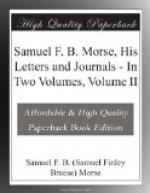The Mayor of New York, A. Oakey Hall, accepted the statue in a short speech, and, after a prayer by the Reverend Stephen H. Tyng, D.D., the assembled multitude joined in singing the doxology, and the ceremonies at the park were ended.
But other honors still awaited the venerable inventor, for, on the evening of that day, the old Academy of Music on Fourteenth Street was packed with a dense throng gathered together to listen to eulogies on this benefactor of his race, and to hear him bid farewell to his children of the Telegraph. A table was placed in the centre of the stage on which was the original instrument used on the first line from Washington to Baltimore. This was connected with all the lines of telegraph extending to all parts of the world. The Honorable William Orton presided, and, after the Reverend Howard Crosby had opened the ceremonies with prayer, speeches were delivered by Mr. Orton, Dr. George B. Loring, of Salem, and the Reverend Dr. George W. Samson.
At nine o’clock Mr. Orton announced that all lines were clear for the farewell message of the inventor to his children; that this message would be flashed to thousands of waiting operators all over the world, and that answers would be received during the course of the evening. The pleasant task of sending the message had been delegated to Miss Sadie E. Cornwell, a skilful young operator of attractive personality, and Morse himself was to manipulate the key which sent his name, in the dots and dashes of his own alphabet, over the wires.
The vast audience was hushed into absolute silence as Miss Cornwell clicked off the message which Morse had composed for the occasion: “Greeting and thanks to the Telegraph fraternity throughout the world. Glory to God in the highest, on earth peace, good will to men.”
As Mr. Orton escorted Morse to the table a tremendous burst of applause broke out, but was silenced by a gesture from the presiding officer, and again the great audience was still. Slowly the inventor spelled out the letters of his name, the click of the instrument being clearly heard in every part of the house, and as clearly understood by the hundreds of telegraphers present, so that without waiting for the final dot, which typified the letter e, the whole vast assembly rose amid deafening cheers and the waving of handkerchiefs.
It was an inspiring moment, and the venerable man was almost overcome by his emotions, and sat for some time with his head buried in his hands, striving to regain his self-control.
When the excitement had somewhat subsided, Mr. Orton said: “Thus the Father of the Telegraph bids farewell to his children.”
The current was then switched to an instrument behind the scenes, and answers came pouring in, first from near-by towns and cities, and then from New Orleans, Quebec, San Francisco, Halifax, Havana, and finally from Hongkong, Bombay, and Singapore.




